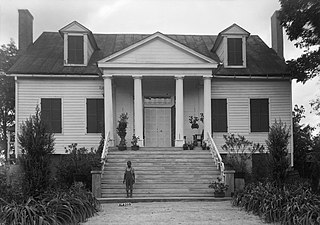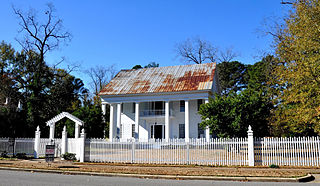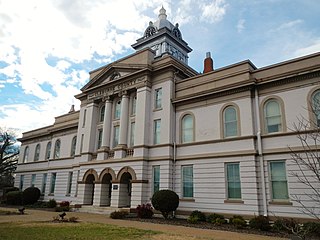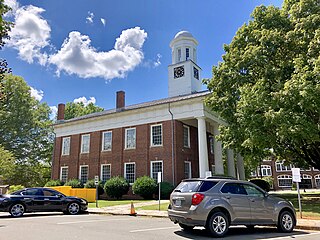
Cahaba, also spelled Cahawba, was the first permanent state capital of Alabama from 1820 to 1825, and the county seat of Dallas County, Alabama until 1866. Located at the confluence of the Alabama and Cahaba rivers, it suffered regular seasonal flooding.

The Pittsylvania County Courthouse is located at 1 North Main Street in downtown Chatham, Virginia, USA. Built in 1853, this Greek Revival building was Pittsylvania County's third courthouse. It was declared a National Historic Landmark in 1987, because it was the scene of events leading to Ex parte Virginia, a United States Supreme Court case extending the Equal Protection Clause to state actions such as jury selection.

Chestertown Historic District is a historic district in Chestertown, Maryland. It was listed on the National Register of Historic Places and designated a National Historic Landmark in 1970, and its area was increased in 1984. The town on the Chester River, became the chief port for tobacco and wheat on the Eastern Shore of Maryland between 1750 and 1790. The port declined thereafter, as Baltimore became the major port for such activity. In consequence, Chestertown acquired a collection of more than fifty Georgian style town houses. The 18th-century residential area survived without harm a 1910 fire that destroyed the central business district of Chestertown.

The Wilcox County Courthouse Historic District is a historic district in Camden, Alabama. It follows an irregular pattern along Broad Street, centered on the Wilcox County Courthouse. The Wilcox County Courthouse was built in 1857 in the Greek Revival style and remains in use today. Alexander J. Bragg was the contractor. The district contains other examples of Greek Revival, Victorian, and vernacular styles of architecture. It was added to the National Register of Historic Places on January 18, 1979.

The Wilcox Female Institute is a historic Greek Revival-style school building in Camden, Alabama. The two-story brick structure was built between 1845 and 1850 as a boarding school for girls. The school closed in 1910 and the building was then used by the Wilcox County school system for over 50 years. It was acquired by the Wilcox Historical Society in 1976. The group made it into their official headquarters. It was placed on the National Register of Historic Places on April 3, 1975.

St. John's-In-The-Prairie, now known as St. John's Episcopal Church, is a historic Episcopal church in Forkland, Alabama.

Boligee Hill, now known as Myrtle Hill, is a historic plantation house near Boligee, Alabama. The Boligee Hill plantation was established in 1835 by Dr. John David Means. He had migrated to Alabama from Newberry, South Carolina. Dr. Means had 110 slaves according to the 1850 Greene County census. The house was built in 1840. It was acquired by the Hays family in 1869 and renamed Myrtle Hall for the sweet myrtle growing around it. The property was restored in 2007 by the Beeker family and renamed Myrtle Hill. The house was placed on the National Register of Historic Places on February 19, 1982 due to its architectural significance.

The David Rinehart Anthony House, also known as the Wynne House, was a historic vernacular Greek Revival style house in Eutaw, Alabama. The house was a two-story wood-framed building on a brick foundation. Four octagonal columns spanned the front portico. It was built in 1860 by David Rinehart Anthony. It was added to the National Register of Historic Places as a part of the Antebellum Homes in Eutaw Thematic Resource on April 2, 1982, due to its architectural significance. It has since been destroyed.

Kirkwood is a historic plantation house in Eutaw, Alabama. The house was recorded by the Historic American Buildings Survey in 1934 and by Carol M. Highsmith in 2010. It was placed on the National Register of Historic Places on May 17, 1976, due to its architectural significance.

The Dr. Willis Meriwether House, also known as the Clark-Malone House, is a historic vernacular Greek Revival style house in Eutaw, Alabama, United States. The house is a two-story wood-framed building on a brick foundation, six square box columns span the front portico. It was built in 1856 by Dr. Willis Meriwether. The house was recorded by the Historic American Buildings Survey in 1934. It was added to the National Register of Historic Places as a part of the Antebellum Homes in Eutaw Thematic Resource on April 2, 1982, due to its architectural significance.

The William Perkins House, now known as the Freemount, is a historic Greek Revival style house in Eutaw, Alabama, United States. The house is a two-story wood-framed building on a raised brick foundation. Four monumental Ionic columns span the front portico. It was built in 1850 by William Perkins on the Eutaw Town Square. According to the 1850 U. S. Federal Census Slave Schedule, William Perkins' household in Greene County included eleven enslaved people, four women and seven men. Their ages ranged from 2-45 years old, and Mr. Perkins is listed as the slave owner. The house was recorded by the Historic American Buildings Survey in 1934. It was added to the National Register of Historic Places as a part of the Antebellum Homes in Eutaw Thematic Resource on April 2, 1982, due to its architectural significance. It is also listed on the Alabama Register of Landmarks and Heritage.

The Edwin Reese House, also known as the Reese-Phillips House, is a historic Greek Revival style house in Eutaw, Alabama, United States. The house is a two-story wood-frame building on a raised brick foundation. Four monumental Ionic columns span the front portico. It was built from 1856 to 1859 by Edwin Reese. The house was recorded by the Historic American Buildings Survey in 1936. It was listed on the Alabama Register of Landmarks and Heritage on October 17, 1980. It was added to the National Register of Historic Places as a part of the Antebellum Homes in Eutaw Thematic Resource on April 2, 1982, due to its architectural significance.

The Asa White House, also known as the White-McGiffert House, is a historic house in Eutaw, Alabama, United States. It was built in 1838 by Asa White, one of Greene County's earliest settlers. Eutaw was established on property owned by Asa White. He conveyed 20 acres (8.1 ha) to the newly established county seat in 1838 for the building of a courthouse, civic buildings, and a commercial district. He then sold residential lots to individuals. His house is a two-story frame building. It was built in the Federal style and later altered with the addition of Greek Revival-influenced details. The house was recorded by the Historic American Buildings Survey in 1936. It was added to the National Register of Historic Places as a part of the Antebellum Homes in Eutaw Thematic Resource on April 2, 1982, due to its architectural significance.

The Coleman–Banks House, also known as the James Oliver Banks House, is a historic Greek Revival style house in Eutaw, Alabama, United States. It was built in 1847 by George W. Shauver. It was purchased by Rhoda Coleman in 1857 and then by James Oliver Banks in 1890. The house is a two-story structure with four monumental Ionic columns spanning the front portico. It features elaborate Greek Revival doorways in the central bay of the front facade. The house was recorded by the Historic American Buildings Survey in 1934. The Greene County Historical Society purchased the house in 1968. It was added to the National Register of Historic Places on December 18, 1970, due to its architectural significance.

The Catlin Wilson House, also known as the Murphy Dunlap House, is a historic Greek Revival style house in Eutaw, Alabama, United States. The one-story wood-framed building was built in 1844. A pedimented front portico with four Doric columns covers the three central bays of the front facade. The house was recorded by the Historic American Buildings Survey in 1936. It was listed on the Alabama Register of Landmarks and Heritage on November 5, 1976. It was subsequently added to the National Register of Historic Places as a part of the Antebellum Homes in Eutaw Thematic Resource on April 2, 1982, due to its architectural significance.

The First Presbyterian Church is a historic Greek Revival church building in Eutaw, Alabama. The two-story frame structure was built for the local Presbyterian congregation in 1851 by David R. Anthony. Anthony was a local contractor who constructed many of Eutaw's antebellum buildings. The congregation was organized by the Tuscaloosa Presbytery in 1824 as the Mesopotamia Presbyterian Church. John H. Gray served as the first minister from 1826 until 1836. The church was added to the National Register of Historic Places on December 16, 1974, due to its architectural and historical significance. The church is a member of the Presbyterian Church in America.

The Greene County Courthouse Square District is a historic district in Eutaw, Alabama. It is centered on the old Old Greene County Courthouse and extends outward along U.S. Route 11 and Alabama State Route 7. It features examples of Greek Revival and commercial architecture. The district was added to the National Register of Historic Places on December 31, 1979.

The Samuel R. Murphy House, also known as the Winfield Scott Bird House, is a historic structure in Eutaw, Alabama. The one-story Greek Revival house was built in the 1850s by Samuel R. Murphy, in part with materials salvaged from the old Mesopotamia Presbyterian Church. It was purchased by Winfield Scott Bird in 1869. The house was placed on the National Register of Historic Places as part of the Antebellum Homes in Eutaw Thematic Resource on April 2, 1982, due to its architectural significance.

The Cleburne County Courthouse is a Classical Revival courthouse in Heflin, Alabama. It was built in 1907, after the county seat of Cleburne County was moved from Edwardsville to Heflin in 1905. The wings of the courthouse were expanded in 1938 using funds from the Federal Emergency Administration of Public Works. It was listed on the National Register of Historic Places in 1976.

Old Orange County Courthouse is a historic courthouse building located at Hillsborough, Orange County, North Carolina. It was built in 1845, and is a two-story, Greek Revival style, temple-form brick structure. It replaced Dickerson Chapel as the county's courthouse. The front facade features a Doric order tetrastyle pedimented portico and two-stage clock tower. The building served as the seat of Orange County's government until 1954, when a new building was completed.





















